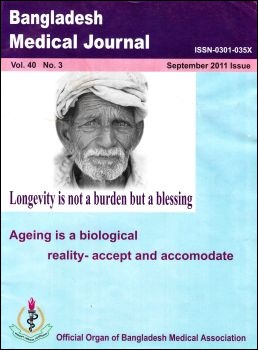Role of Maternal Iron Status in the Pathogenesis Of Gestational Diabetes Mellitus
DOI:
https://doi.org/10.3329/bmj.v40i3.18678Keywords:
GDM, Iron overload, Ferritin, Soluble Transferrin Receptor, Anemia in pregnancyAbstract
Gestational diabetes mellitus (GDM) is one of the commonest complications of pregnancy; but its pathophysiology is still not fully understood. Recently attention has been focused on the relation between iron metabolism and glucose intolerance in the genesis of GDM. The present study was conducted to investigate the association of body iron store with various covariates of metabolic syndrome. A total 100 subjects were included in this study: 43 were healthy nondiabetic and nonanemic pregnant women (Control group) and 57 were pregnant women having Diabetes Mellitus (GDM group). Glucose level was measured by using glucose-oxidase method, fasting serum C-peptide by chemiluminescent enzyme immunoassay, Glycosylated hemoglobin (HbA1c) by using a modified high performance liquid chromatography (HPLC) method and insulin sensitivity (HOMA%S) and insulin secretory capacity (HOMA%B) were calculated by Homeostasis Model Assessment. Serum transferrin receptor (STfR) was measured by Enzyme-Linked Immunosorbent Assay and serum ferritin level was assessed by Microparticle Enzyme Immunoassay. Serum iron concentration was measured by IRN method. The age of the study groups were found to be matched (p=0.522). Gestational weeks and parity of the study groups were significantly higher in GDM than Controls (p=0.004 and p=0.015 respectively). HbA1c level (%, M±SD) was significantly higher in GDM group (6.09±1.1) as compared to Control Among the marker of body iron status hemoglobin level showed no difference between GDM (11±1.25) and Control groups (10.6±0.8), but serum iron concentration [median (range)] was significantly lower in GDM group [6(2-19)] as compared to Control [12(2-36)].Serum Iron was strongly correlated with HOMA%B in univariate Spearman correlation analysis (r =0.347, P=0.008).On multivariate linear regression analysis also found Serum Iron associated (p=0.011) with HOMA% B in GDM group. GDM in Bangladeshi subjects does not seem to be associated with iron deficiency or elevated body iron store. GDM subjects may show lower serum iron, but this is probably related to chronic inflammatory state of diabetes rather than iron deficiency.
DOI: http://dx.doi.org/10.3329/bmj.v40i3.18678
Bangladesh Medical Journal 2011 Vol.40(3):55-60
Downloads
296
268

